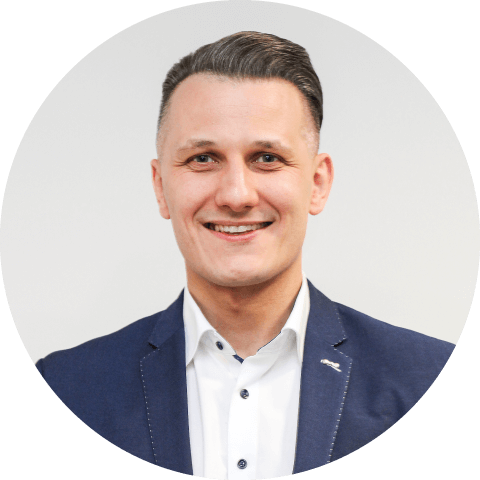Customer experience from a tech company for a tech industry – Interview with Marcin Waleczko
In today’s interview from the Spyrosoft People series, we talk to Marcin Waleczko, the Director of Customer Experience Hub (CX-Hub) in Spyrosoft. We are discussing the importance of having customer services in the organisation and how CX is executed by a technology company for other tech businesses.
How did your career lead you to become Director of Customer Experience Hub?
For me, taking on the role of Director of Customer Experience Hub was a fairly natural step since I had worked in business development for many years. In fact, most of my 16-year professional career was concentrated around first sales and then business development in technology companies. The form of business development itself is evolving and has changed quite a lot over the last few years. Business development used to be mainly about selling new products to new customers. Nowadays, we have a situation where there are a lot of customers interested in cooperation, who come to us directly. Therefore, business development has started to focus more on creating additional value, something new that few in the market offer. All of that is to provide customers with a unique value that they won’t get from anyone else, and so that they will stay with us for a longer time. And for me, this is where customer experience comes in. It is a natural part of my growth because it is also another element in which a technology company can provide a service to its customers.
What does bringing customer experience to the table mean for our business, and what areas does it help us cover?
Having customer services allows us to offer more to our clients. If we consider how products are created these days, we will see that every product goes through a similar life cycle. Even assuming that we as a technology company support CX and customer service activities only for clients who are also in the IT industry, we can see that this product cycle also applies to digital products. So, there is the conceptual phase, where specialists invent a product. They determine how it should look, behave, and what the user’s interaction with this product should be. And in our group, this is handled by Unravel. There is also the product development stage. In our case, it is the delivery of software. That means we get involved in the projects, and we take full responsibility for the development of the application. And these are the two most typical elements that can be found in the offers of most companies in our sector. Of course, we also do them.
However, once the product is developed and functioning in the business landscape, we also offer maintenance services. We call these IT managed services, which include all maintenance services, with a clearly defined SLA. This means that we take care of the already created and working product, and we ensure that it will work according to the rules agreed with the client. These three parts are the basic elements that for many years seemed to most people in the IT service / digital transformation industry to suffice and close the product life cycle.
At some point, we started to wonder what happens next, how this application continues to function, and what our client does with it. We figured out that clients with already running applications or services may still need some support. There are always end-users who use application or service that has been delivered to our client and despite the best intentions and the best design concepts, it may not always fully meet the expectations of all end-users. Sometimes users may find things that don’t work and need fixing, or there may be technical questions about what the app is and what data it provides or collects, or it’s a natural step in the process that end-user engages with someone from customer service. Being able to address those needs at the end of the process, allows us to provide clients with the experience of what is called The Last-Mile Customer Service. Having this last piece of the puzzle in our interactions with customers helps us cover the niche that exists in the market.
Why is customer experience such a crucial element in our portfolio?
It is so important to us because it perfectly complements our offering and, as I mentioned before, it helps us fill a gap in the market. Thanks to the CX teams, we can help our customers communicate with their end-users, and therefore fulfil their defined customer experience strategy in an appropriate way.
With our Customer Experience service for corporate clients, we fit into a gap in the market that, I think, is quite large. It seems that companies that offer this service by default are usually various types of call centres or companies that have grown out of call centres. And these are not companies that provide software development, on the contrary, they usually have a slightly different business profile. As a result, they are not always able to communicate at a high technical level with all their users or corporate clients.
This is where we come in as a company that offers customers a walk-through of all elements of a digital product’s life. We do design, we do delivery, we do maintenance, and now we also support the end-users of the products that our customers offer, which can be seen as a key and critical service. And since we have big technical experience and knowledge, we can use it to our advantage.
What is our approach to customer experience services, what do we offer and what do we focus on?
Generally, the ideal, complete model for customer experience should start somewhere from the planning of the CX strategy for or with our customers. It is possible to offer a service to support the planning of such a strategy, however, we do not provide this. Simply, because this is not the domain of a tech company, but rather of firms that build strategies or perhaps marketing agencies. The next thing is to develop processes to support the created strategy. This includes arrangements for workflow, how, where and when customer service teams work, and what tools they use. This is less of a strategic element and more of an executive element, something that we in Spyrosoft do, but not fully. Today, we do not yet provide such classic consulting services, assuming that our clients plan their CX related processes on their own, having domain experts onboard.
The moment when our knowledge is invaluable is when we start choosing the tools to build the expert teams that will then do the actual work and support the users. And this is somewhat reminiscent of our software development service. This means that we are able to build a team of experts, deliver them to the customer and integrate them into the process defined by the client. Then further we also can support the client in the selection, optimisation and implementation of tools which will facilitate the customer service process. Tools that improve communication with the end-user, as well as enable data connection with back-office systems.
What advantages do we have over our competition?
We should start by defining who our competitors really are here, who can be treated as competitors and who should not be considered as such. I mentioned earlier that the natural place where you are looking for help if you need to build customer services are all kinds of call centre companies. Now, are they, our competitors? Of course, in some simple cases, they can be. However, in situations where it is necessary to build a team with strong, deep technological knowledge, a call centre company might not do it. Their business model does not include it, or they simply lack such competences. So, in this case, knowledge and experience is our advantage.
Another competition for us may be IT companies that provide various services in addition to software development. Nowadays, there are still few such organisations, most of them are firms that specialize in specific services and don’t provide A-Z solutions. However, if a classic software house decides to provide some additional services apart from software development, we can also see them as a competitor. Now, how many such companies are there on the market? Looking at firms in SoDA or similar to Spyrosoft that would also provide services other than classic software development or classic team extension, there are few companies on the list. This means that our competitors are at least medium-sized or large IT companies that provide additional services besides software development and team extension. But there aren’t many of them on the market, so in a way, our advantage is that we have filled a certain market niche.
How can our experience as a technology company influence CX collaboration with clients?
Since we are a technology company, and we provide classic technology services to the client: design, development, delivery of an application or a team, this customer experience service, which is more technology-oriented, is now a natural continuation of our offering. This gives the customer the opportunity to deal with all aspects of the product life cycle in one place, by one vendor. Our pre-existing offer and technological experience, now complemented by a customer support offer, makes us, as Spyrosoft, able to provide the client with complete solutions, prepared from A to Z. We aim to allow the client to follow our full consumer path from both ends of the offer.
This means that, of course, clients who start cooperation with us from design or software development, later have the opportunity to use our customer experience offer. Nevertheless, our new-generation customer support service gives a chance to reverse this path. In other words, when we start cooperation with clients with our CX service, we are, at the same time, able to give them the possibility to address other areas related to software development with us. So, we can start with customer support for the application, then we can take care of such an application as a part of IT managed services offering to end up providing traditional software development services. Regardless of which side of the process we start from, we can go through the full path with the customer. And this is undoubtedly our strong market advantage.
What are our main market advantages and what makes our offer unique?
There is another dimension of advantages that, as an experienced technology company, we have that I have not yet mentioned. Nowadays, especially in the post-pandemic era, the IT sector looks vastly different from it did a few years ago. The primary challenge is no longer to find a new customer but to find talents and build the proper team of professionals. The fact that we, as a group, have close to 1,200 people on board today, proves that we operate very efficiently in terms of building these teams. Our internal processes related to hiring, training, and retaining employees in the organization are done very well. And all of this shows the customer that even though the market has been a bit tougher lately, we can still be relied on. It also indicates that we are able, in cooperation with our experienced back-office and a team of more than 20 recruiters, to effectively hire and retain specialists, whose knowledge and skills we can later use when providing customer experience services to the client. And that’s really invaluable, that kind of advantage is unique, and not many companies can boast of that.
There are other key advantages that our company has over our competitors. To sum up, what I have mentioned above, the key element is that today we can address every point in a digital product life cycle, comprehensively from A to Z. Another essential element is that we know how to do IT solutions. As a tech firm ourselves, we provide IT services and software development with great success, and we have proved that many times.
____
If you are interested in cooperating with Marcin Waleczko and his Customer Experience team, check the offer and contact our experts.
About the author
RECOMMENDED READING:




